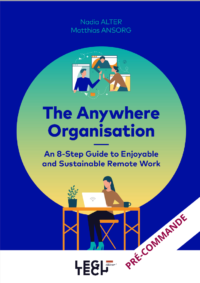This book breaks new ground into the art of remote working (the authors call it distributed collaboration). The authors propose that remote working, done right, yields many benefits on workers’ well-being and personal freedom, reduction of carbon emissions via abatement of commuting and business travel, and general sanity of the workplace. With respect to other accounts of the same topic this one stands out in three respects.
First, it is not a book about digital tools: no techno-fetishism in sight. There is plenty of discussion of digital tools, but the authors prefer to highlight good organization practices over gizmos. Such practices can and should be supported by digital tools, but the book itself is agnostic over exactly which ones should be used.
Second, there is a key insight: remote working is about working together, emphasis on « together ». To do it successfully, people need to think of themselves as a unit. Everybody takes steps to improve their co-workers’ experience. Early in the book, monastic communities are evoked as an example of beautiful, highly efficient, long-term sustainable teams.
And third, you can feel the thickness of experience. The authors have been doing this for a long time, have tried and failed and tried again over the years. The company they founded has been cited as an innovator amongst a new breed of organisations started by digital natives who are now bypassing existing entities.



